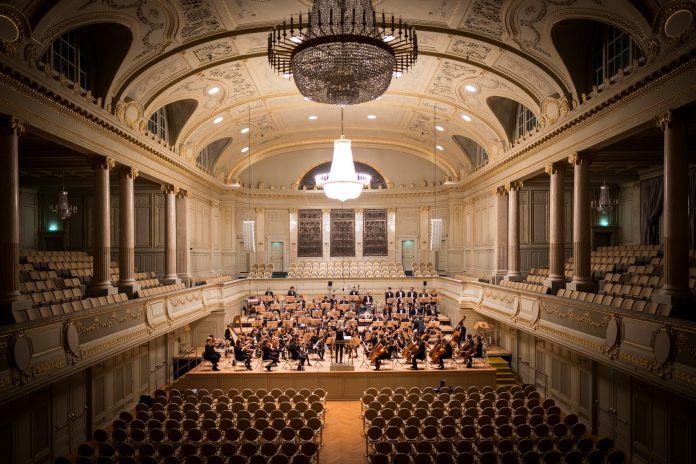Holger Ziegeler served as Consul General of Germany in Karachi, Pakistan, implementing diplomatic activities. On August 21st 2022, the Consulate General of the Federal Republic of Germany presented a concert in Karachi, celebrating the works of the renowned German composer Johann Sebastian Bach.
Born in 1685, Johann Sebastian Bach is widely regarded as the greatest composer in the history of classical music. His creative timeline ran parallel to that of Shah Abdul Latif Bhittai, a Sindhi Sufi mystic and one of the Eastern world’s most celebrated poets.
Like Latif’s poetry, Bach’s compositions were based on deep reflection, often incorporating religious themes and connecting traditional and folkloric elements with divine love. Latif’s abyat poems were created to be performed against a musical backdrop, in a style reminiscent of Bach’s beautifully tranquil Aria, the baseline and chord progression of which incorporates the Goldberg Variations. Lasting around 90 minutes, the Goldberg Variations were played at this astounding concert in Karachi.
Bach produced this long and complicated keyboard piece in 1741. His aim in doing so was to showcase the musical variation, technical development, compositional sophistication, and virtuosic finesse that could be achieved through keyboard music.
Comprising a set of 30 compositions created on the harpsichord, the Goldberg Variations are the fourth edition of Bach’s series of compositions titled ‘Clavier-Übung’, which translates to English as ‘keyboard practice’. These works are considered to be one of classical music’s most important examples of variation form and are named in honor of Johann Gottlieb Goldberg, who – according to anecdote – is believed to have performed the piece for his employer, Count Keyserlingk.
Johann Sebastian Bach was born to a family of musicians. Indeed, most of his relatives were musically inclined, with several of his uncles and close relatives earning a living as professional musicians. Bach’s father directed music in his hometown, and his brothers were also employed as musicians. In fact, the Bach family is known to have produced at least 50 known musicians, with their musical talent spanning seven generations.
Bach’s elder brother played an important role in the composer’s success. The siblings lost their parents when Bach was aged just 10 years old. Johann’s elder brother took him into his care, providing not just a home but also valuable music lessons, enabling Bach to learn to play the clavichord and the organ at St Michael’s church. Indeed, Johann Sebastian Bach learned much of his early music from his brother, emulating his musical style and the types of music he heard his brother play. Whilst living with his brother, Bach also learned to speak Latin, Greek, Italian, and French.
Studying at St Michael’s School, the young Bach found the teachers innovative and demanding in equal measure. They encouraged students to think critically and devise solutions to problems presented to them. Attended by students from all parts of the country, most from affluent families, St Michael’s School’s mode of teaching helped to open the mind of the young Bach, setting him in good stead to realize his talent and achieve his ambitions.
Bach’s first assignments were with the church, and some of his notable contracts were playing as an organist at St Michael’s Church. In this role, his performance was exemplary, earning him top marks with the church’s leadership. During this period, Bach also worked as a composer, then as a musical director at St Thomas, with his exceptional professional reputation opening even more doors.
In addition to his global acclaim as one of the most celebrated composers of all time, regularly topping greatest composer lists even today, Johann Sebastian Bach was also adept at building and playing organs, as well as conducting music and playing the harp. He enhanced several musical works produced by previous generations. Some of Bach’s most celebrated works include The Well-Tempered Clavier, The Mass in B Minor, and Brandenburg Concertos.
Johann Sebastian Bach published the Goldberg Variations as the capstone of the Clavier-Übung, with this long and complicated piece showcasing all that was possible on the keyboard at the time. Each third variation in the series of 30 is a canon, following an ascending pattern. Thus, the third variation is a canon at the unison; the sixth variation is a canon at the second; and so on until variation 27, which is a canon at the ninth. Rather than being a canon in the tenth as anticipated, the final variation is a quodlibet, breaking the musical cycle.
The themes of the Goldberg Variations are rooted in German folk songs, centering around topics varying from joyful reunions and family customs to beloved and not-so-beloved family meals. Each variation between canons is also arranged in a pattern, incorporating genre pieces of various musical styles, from French overtures to Baroque dances to arabesques.
In total, Johann Sebastian Bach is credited with composing more than 1,000 musical pieces throughout the course of his lifetime. Five of the ten children that survived Bach followed him into musical careers. In his day, not all of the composer’s works were appreciated, with some considered old-fashioned. Nevertheless, Johann Sebastian Bach is widely recognized today as one of the most talented musical composers of all time.

